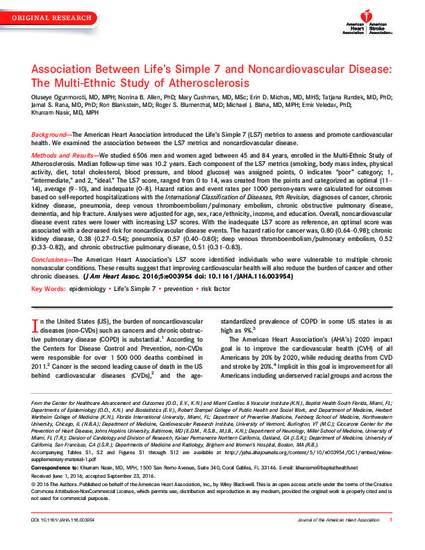
Background The American Heart Association introduced the Life's Simple 7 (LS7) metrics to assess and promote cardiovascular health. We examined the association between the LS7 metrics and noncardiovascular disease.
Methods and Results We studied 6506 men and women aged between 45 and 84 years, enrolled in the Multi‐Ethnic Study of Atherosclerosis. Median follow‐up time was 10.2 years. Each component of the LS7 metrics (smoking, body mass index, physical activity, diet, total cholesterol, blood pressure, and blood glucose) was assigned points, 0 indicates “poor” category; 1, “intermediate,” and 2, “ideal.” The LS7 score, ranged from 0 to 14, was created from the points and categorized as optimal (11–14), average (9–10), and inadequate (0–8). Hazard ratios and event rates per 1000 person‐years were calculated for outcomes based on self‐reported hospitalizations with the International Classification of Diseases, 9th Revision, diagnoses of cancer, chronic kidney disease, pneumonia, deep venous thromboembolism/pulmonary embolism, chronic obstructive pulmonary disease, dementia, and hip fracture. Analyses were adjusted for age, sex, race/ethnicity, income, and education. Overall, noncardiovascular disease event rates were lower with increasing LS7 scores. With the inadequate LS7 score as reference, an optimal score was associated with a decreased risk for noncardiovascular disease events. The hazard ratio for cancer was, 0.80 (0.64–0.98); chronic kidney disease, 0.38 (0.27–0.54); pneumonia, 0.57 (0.40–0.80); deep venous thromboembolism/pulmonary embolism, 0.52 (0.33–0.82), and chronic obstructive pulmonary disease, 0.51 (0.31–0.83).
Conclusions The American Heart Association's LS7 score identified individuals who were vulnerable to multiple chronic nonvascular conditions. These results suggest that improving cardiovascular health will also reduce the burden of cancer and other chronic diseases.
Available at: http://works.bepress.com/emir-veledar/14/

Originally published in the Journal of the American Heart Association.